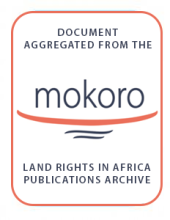Land Library
Welcome to the Land Portal Library. Explore our vast collection of open-access resources (over 74,000) including reports, journal articles, research papers, peer-reviewed publications, legal documents, videos and much more.
/ library resources
Showing items 1 through 9 of 25.This article discusses the extent to which the location of roads s and protected areas affects deforestation in North Thailand.
Articles in this edition develop several areas and introduce specific experiences relating to land reform. The main thread running through the articles is that of change; how we can help to understand what change means and how it can be managed.
The purpose of the present Law is to safeguard the public interest on the occasion of the transfer of land or parts thereof, taking into account the need to comply with the principles of a sustainable protection of the environment, nature and landscape.
"The hour of capitalism's greatest triumph," writes Hernando de Soto, "is, in the eyes of four-fifths of humanity, its hour of crisis." In The Mystery of Capital, the world-famous Peruvian economist takes up the question that, more than any other, is central to one of the most crucial problems th
For co-management of conservation areas to be effective, detailed information on local people's use of natural resources is essential. One method to obtain some of that information, a household record keeping study, is given.
The analysis of `ambiguous lands' and the people who inhabit them is most revealing for understanding environmental deterioration in Thailand. `Ambiguous lands' are those which are legally owned by the state, but are used and cultivated by local people.
Over the last decade, forests have played an important role in the transition from war to peace in Cambodia. Forest exploitation financed the continuation of war beyond the Cold War and regional dynamics, yet it also stimulated co-operation between conflicting parties.
Summarises the 12 presentations made at the workshop, 8 of which concerned Mozambique, the remainder Sao Tome & Principe, Angola, Guinea Bissau and Cabo Verde.
The various legal, political, economic and social perspectives that have influenced the land reform discourse in Kenya are examined.






